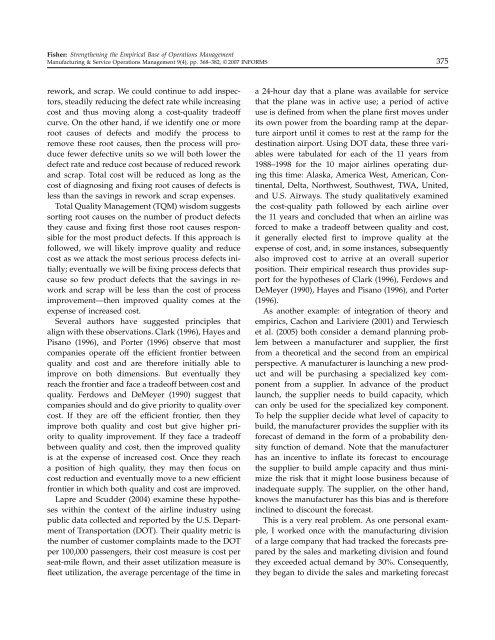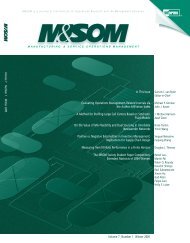Strengthening the Empirical Base of Operations Management
Strengthening the Empirical Base of Operations Management
Strengthening the Empirical Base of Operations Management
You also want an ePaper? Increase the reach of your titles
YUMPU automatically turns print PDFs into web optimized ePapers that Google loves.
Fisher: <strong>Streng<strong>the</strong>ning</strong> <strong>the</strong> <strong>Empirical</strong> <strong>Base</strong> <strong>of</strong> <strong>Operations</strong> <strong>Management</strong><br />
Manufacturing & Service <strong>Operations</strong> <strong>Management</strong> 9(4), pp. 368–382, © 2007 INFORMS 375<br />
rework, and scrap. We could continue to add inspectors,<br />
steadily reducing <strong>the</strong> defect rate while increasing<br />
cost and thus moving along a cost-quality trade<strong>of</strong>f<br />
curve. On <strong>the</strong> o<strong>the</strong>rhand, if we identify one ormore<br />
root causes <strong>of</strong> defects and modify <strong>the</strong> process to<br />
remove <strong>the</strong>se root causes, <strong>the</strong>n <strong>the</strong> process will produce<br />
fewerdefective units so we will both lower<strong>the</strong><br />
defect rate and reduce cost because <strong>of</strong> reduced rework<br />
and scrap. Total cost will be reduced as long as <strong>the</strong><br />
cost <strong>of</strong> diagnosing and fixing root causes <strong>of</strong> defects is<br />
less than <strong>the</strong> savings in rework and scrap expenses.<br />
Total Quality <strong>Management</strong> (TQM) wisdom suggests<br />
sorting root causes on <strong>the</strong> number <strong>of</strong> product defects<br />
<strong>the</strong>y cause and fixing first those root causes responsible<br />
for <strong>the</strong> most product defects. If this approach is<br />
followed, we will likely improve quality and reduce<br />
cost as we attack <strong>the</strong> most serious process defects initially;<br />
eventually we will be fixing process defects that<br />
cause so few product defects that <strong>the</strong> savings in rework<br />
and scrap will be less than <strong>the</strong> cost <strong>of</strong> process<br />
improvement—<strong>the</strong>n improved quality comes at <strong>the</strong><br />
expense <strong>of</strong> increased cost.<br />
Several authors have suggested principles that<br />
align with <strong>the</strong>se observations. Clark (1996), Hayes and<br />
Pisano (1996), and Porter (1996) observe that most<br />
companies operate <strong>of</strong>f <strong>the</strong> efficient frontier between<br />
quality and cost and are <strong>the</strong>refore initially able to<br />
improve on both dimensions. But eventually <strong>the</strong>y<br />
reach <strong>the</strong> frontier and face a trade<strong>of</strong>f between cost and<br />
quality. Ferdows and DeMeyer (1990) suggest that<br />
companies should and do give priority to quality over<br />
cost. If <strong>the</strong>y are <strong>of</strong>f <strong>the</strong> efficient frontier, <strong>the</strong>n <strong>the</strong>y<br />
improve both quality and cost but give higher priority<br />
to quality improvement. If <strong>the</strong>y face a trade<strong>of</strong>f<br />
between quality and cost, <strong>the</strong>n <strong>the</strong> improved quality<br />
is at <strong>the</strong> expense <strong>of</strong> increased cost. Once <strong>the</strong>y reach<br />
a position <strong>of</strong> high quality, <strong>the</strong>y may <strong>the</strong>n focus on<br />
cost reduction and eventually move to a new efficient<br />
frontier in which both quality and cost are improved.<br />
Lapre and Scudder (2004) examine <strong>the</strong>se hypo<strong>the</strong>ses<br />
within <strong>the</strong> context <strong>of</strong> <strong>the</strong> airline industry using<br />
public data collected and reported by <strong>the</strong> U.S. Department<br />
<strong>of</strong> Transportation (DOT). Their quality metric is<br />
<strong>the</strong> number<strong>of</strong> customercomplaints made to <strong>the</strong> DOT<br />
per100,000 passengers, <strong>the</strong>ircost measure is cost per<br />
seat-mile flown, and <strong>the</strong>irasset utilization measure is<br />
fleet utilization, <strong>the</strong> average percentage <strong>of</strong> <strong>the</strong> time in<br />
a 24-hourday that a plane was available forservice<br />
that <strong>the</strong> plane was in active use; a period <strong>of</strong> active<br />
use is defined from when <strong>the</strong> plane first moves under<br />
its own power from <strong>the</strong> boarding ramp at <strong>the</strong> departure<br />
airport until it comes to rest at <strong>the</strong> ramp for <strong>the</strong><br />
destination airport. Using DOT data, <strong>the</strong>se three variables<br />
were tabulated for each <strong>of</strong> <strong>the</strong> 11 years from<br />
1988–1998 for<strong>the</strong> 10 majorairlines operating during<br />
this time: Alaska, America West, American, Continental,<br />
Delta, Northwest, Southwest, TWA, United,<br />
and U.S. Airways. The study qualitatively examined<br />
<strong>the</strong> cost-quality path followed by each airline over<br />
<strong>the</strong> 11 years and concluded that when an airline was<br />
forced to make a trade<strong>of</strong>f between quality and cost,<br />
it generally elected first to improve quality at <strong>the</strong><br />
expense <strong>of</strong> cost, and, in some instances, subsequently<br />
also improved cost to arrive at an overall superior<br />
position. Their empirical research thus provides support<br />
for <strong>the</strong> hypo<strong>the</strong>ses <strong>of</strong> Clark (1996), Ferdows and<br />
DeMeyer(1990), Hayes and Pisano (1996), and Porter<br />
(1996).<br />
As ano<strong>the</strong>r example: <strong>of</strong> integration <strong>of</strong> <strong>the</strong>ory and<br />
empirics, Cachon and Lariviere (2001) and Terwiesch<br />
et al. (2005) both considera demand planning problem<br />
between a manufacturer and supplier, <strong>the</strong> first<br />
from a <strong>the</strong>oretical and <strong>the</strong> second from an empirical<br />
perspective. A manufacturer is launching a new product<br />
and will be purchasing a specialized key component<br />
from a supplier. In advance <strong>of</strong> <strong>the</strong> product<br />
launch, <strong>the</strong> supplierneeds to build capacity, which<br />
can only be used for<strong>the</strong> specialized key component.<br />
To help <strong>the</strong> supplierdecide what level <strong>of</strong> capacity to<br />
build, <strong>the</strong> manufacturer provides <strong>the</strong> supplier with its<br />
forecast <strong>of</strong> demand in <strong>the</strong> form <strong>of</strong> a probability density<br />
function <strong>of</strong> demand. Note that <strong>the</strong> manufacturer<br />
has an incentive to inflate its forecast to encourage<br />
<strong>the</strong> supplierto build ample capacity and thus minimize<br />
<strong>the</strong> risk that it might loose business because <strong>of</strong><br />
inadequate supply. The supplier, on <strong>the</strong> o<strong>the</strong>r hand,<br />
knows <strong>the</strong> manufacturer has this bias and is <strong>the</strong>refore<br />
inclined to discount <strong>the</strong> forecast.<br />
This is a very real problem. As one personal example,<br />
I worked once with <strong>the</strong> manufacturing division<br />
<strong>of</strong> a large company that had tracked <strong>the</strong> forecasts prepared<br />
by <strong>the</strong> sales and marketing division and found<br />
<strong>the</strong>y exceeded actual demand by 30%. Consequently,<br />
<strong>the</strong>y began to divide <strong>the</strong> sales and marketing forecast




